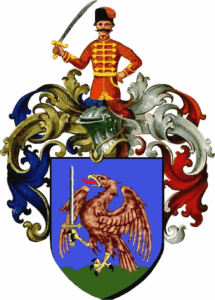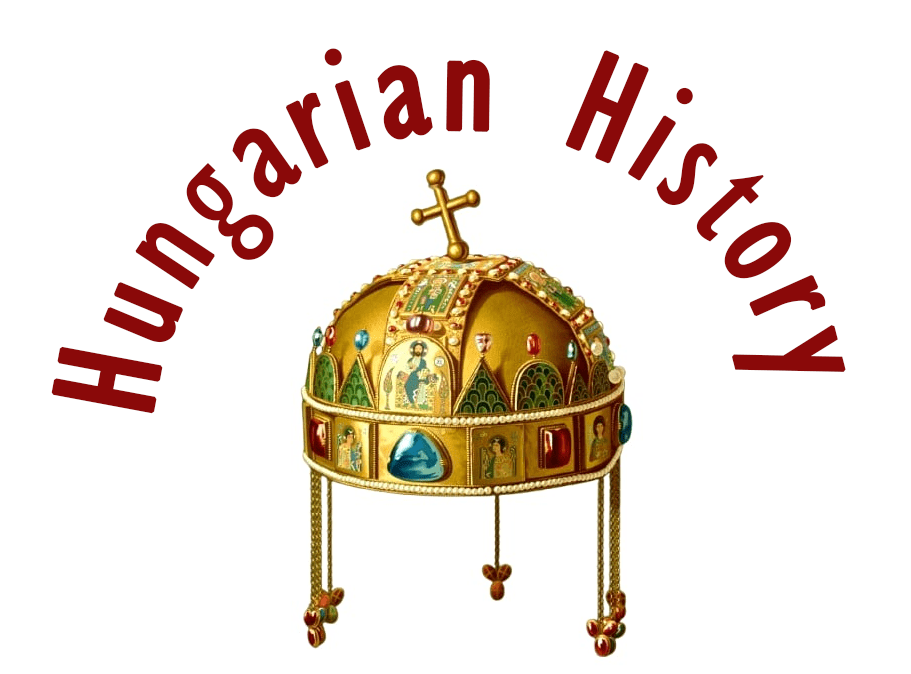Kékkő

The castle of Kékkő (Modrý Kameň), was the famous castle of the poet and warrior Balassi Bálint. Kékkő, in Hungarian, means “bluestone”, and is located in the Upper lands/Horná Zem/Felvidék, it is in Slovakia, near Besztercebánya (Banská Bistrica), guarding the road towards the Mining Towns’ district.
Location: https://tinyurl.com/4ka48x79
The Comes of Zólyom County controlled a vast forest in the northern part of the Kingdom of Hungary. The Comes of Zólyom County was called the Forró Péter, Son of Mikó from the Zólyomi Clan. They were the ancestors of the Balassa family, and it was Lord Forró who had Kékkő castle built in the 1270s. (Please note that I use the Oriental name order for Hungarians ,where family names come first.)

Lord Forró’s daughter was married to Lampert, Son of Kázmér from the Hontpázmány Clan, who took Kékkő castle in his possession when Lord forró died in 1285. He has even occupied the castle of Gyarmat, a nearby fort where a stone tower stood in the middle. He should not have done so because he just angered the family of his wife, whose soldiers besieged Gyarmat and Kékkő in 1290 with the help of the powerful Lord Demeter, Comes of Pozsony, and Zólyom counties.
It was how the castle was first mentioned as Keykkw in that year. The new owner, Byter, was so grateful to Lord Demeter that he gave him one-third of his ownership over Kékkő castle. Comes Demeter could gain Gyarmat castle as well, in exchange for his unselfish military aid. We must remark that Comes Demeter was a cousin of Lord Byter.

Later, the castle was taken by Lord Csák Máté, and his soldiers had been guarding it until the death of this mighty oligarch in 1321. Then, the Zólyomi family (the ancestors of the Balassa family) owned it for a long time. The Czech Hussite mercenaries were occupying large areas of Upper Hungary’s Eastern and middle parts between 1440-1462, but they could not take Kékkő castle.

The Balassa family could beat them back each time. On the whole, the Balassa family has always been renowned for its violent and fierce members. For example, Lord Balassa Balázs acted like a robber knight when he ambushed the Monastery of Ság in 1444 and had all the valuables carried away from there to Kékkő castle.
After the Battle of Mohács in 1526, the fatal Dual Kingship tore the country in two. Unluckily, Kékkő was located roughly on the border of King Habsburg Ferdinand’s and King Szapolyai János’ lands. No wonder that the members of the Balassa family were wavering between the two kings. They always tried to side with the stronger one, gaining new lands for their loyalty. It was not utterly uncommon nor outrageous at that age.

When Buda fell in 1541, many Hungarian lords decided to swear fealty to the Habsburgs, who seemed to have lots of Western resources to defend them against the Ottoman onslaught. The Balassa family became one of them. They required help, indeed: the Ottomans burned the villages between Gyarmat, Szécsény, and Kékkő castles in 1547. The Akindjies took countless captives from the peasants, thus weakening the Balassa family. Still, the Balassa family members decided to wage wars against each other, which made the anti-Ottoman defense more difficult.

We can find only 50 Hussars in Kékkő castle in 1554. Dark days were coming, although the castle was rebuilt due to the Ottoman threat in the 1560s. On the last day of the Diet of Pozsony in 1569, Emperor Habsburg Maximilian had Balassa János and his brother-in-law, Dobó István of Ruszka, arrested. They were accused of treason: allegedly, they had been secretly plotting with the followers of the Transylvanian ruler, János Zsigmond. Lord Balassa János managed to break out of his custody (which was a part of the Royal Palace in the castle of Pozsony) during the next year’s spring. He ran to Zólyom, then fled to his property in Dunajec, which was in Poland.

The Emperor confiscated Zólyom and Liptóújvár castles from him, but the castles of Kékkő and Divény could remain in the hands of the Balassa family. The political situation could change only after the death of János Zsigmond in 1571. Balassa and Dobó received a royal pardon: Lord Balassa knelt before the Emperor on 11 August 1572 in Vienna, and soon he regained all his properties. When the Habsburg heir was crowned, Lord Balassa’s son, Bálint, was following him as his cupbearer.

1575 June-July: Sokollu Mustafa Pasha of Buda takes the castles of Kékkő and Divény
The year 1575 was another eventful one in the Borderlands. On December 12, 1574, Sultan Selim II died and was succeeded by Murad III. The new padishah was no longer bound by the Treaty of Drinapolis of 1568, and the Ottoman invasions of the Hungarian Borderland began in January of the following year.

In mid-January, an attack was launched against the castle under construction in Kálló, which ended in a Hungarian victory in Böszörmény.
In the spring, a Turkish raid reached the town of Eger, and attacks were also launched towards the mining towns of the Highlands and the county of Nyitra. Botszentgyörgy in Zala was attacked but repulsed, and in August Fonyód fell.

The Turkish marauders reached the area of Kanizsa several times, and in September, the Bey of Bosnia defeated Herbart von Auersperg at Petrinja. And Bekes Gáspár, with tacit Habsburg support, attempted to conquer Transylvania but was defeated by Báthory István at Kerelőszentpál in the summer of that year. Balassi Bálint, the son of Balassa (Balassi) János, lord of Kékkő and Divény, was also taken prisoner.

Balassa’s life was full of twists and turns, and in the late 1560s, he even flirted with the idea of siding with János Zsigmond with his brother-in-law, the heroic Dobó István of Eger, for which they were both thrown into prison. Balassa escaped from there in 1570, and he seems to have offered himself to the Porte, which received his letter coldly.

At the time, a war was breaking out between Venice and the Ottoman Empire over Cyprus, one of the defining events of which was the naval battle of Lepanto in October 1571. The Sultan was in no mood for another conflict with the Habsburgs over a Hungarian overlord, so Balassa was ordered to wait and send further news. And when King Maximilian pardoned him in August, the Sublime Porte turned its back on him for good.

His reputation became increasingly suspect at the Sultan’s court, especially after he defeated an Ottoman army that had destroyed the mining towns around Selmec in March 1575. The Buda Pasha, Sokollu Mustafa, who until then had conveyed the views of the Porte to Balassa, was completely outraged by the Hungarian overlord’s actions. Taking advantage of or even using as an excuse the fact that Balassa’s son Bálint had joined Bekes Gáspár and marched against the Turkish vassal Transylvania in the summer of 1575, he attacked Balassa’s castle, declaring the act a breach of the peace.

According to the contemporary historian Istvánffy, the immediate cause of the attack was Balassa’s cunning trick of luring the Pasha’s men into a trap with his Turkish prisoners (perhaps he also tricked Mustafa with the promise of siding with the Turks).

The Pasha’s first target was Kékkő. Balassa left on the pretext of calling for help, leaving the command to Temesy (alias Pribék) Imre. Forgách Simon, captain-general of Upper Hungary with the insurgent nobility, and Andreas Kielmann of Kielmansegg, captain-general of Komárom with the royal troops of Komárom, Győr and Pápa, gathered troops. However, the gathering of the army at Végles was delayed, which allowed Mustafa to easily take Kékkő. The more so as the defenders bravely repulsed the first attack, but secretly abandoned the castle before the second attack and fled to Divény. Dévény Castle was thus taken after a particularly bloody fight. As it turned out, these two Balassa castles became the northernmost conquests of the Ottoman Empire.

Here, too, the Turks followed Temesy, who put up a stronger resistance. However, after the captain and part of the guard fell, the rest of the soldiers, frightened, left the fortress of Divény, but the Turks heard of this and went after them. The soldiers who were reached by the Turks were routed, and the officers also fell, with only one officer of Serbian origin reported to have escaped. According to other sources, many of them took refuge in Eger.

After the capture of the two Balassi castles, Mustafa also took another small fortress, Somoskő, wedged between Salgó, Fülek, and Ajnácskő, which were under Turkish control. Captain Fodróczy Miklós also fled to Eger. Balassa was furious, but the relief army did not move. King Maximilian also protested in vain against the apparent breach of the peace, only to receive a series of letters in which Balassa offered his services to the Porte. The Sultan added that the fact that the lord’s son had joined Bekes’ army was a clear breach of the peace for which the father deserved punishment.

Interestingly, Balassa’s search for contacts with the Ottomans is by no means finished. In December 1575, Mustafa Pasha granted him a letter of protection, and a year later, word arrived in Constantinople that he would join the Turkish side with the overlord’s men to secure his son’s release. To this end, he sent two of his prisoners to the Grand Vizier. But by the time the plan for this attempt was presented to the Sultan, Balassa János was no longer alive.

The change of Sultan and the clashes of 1575 prompted King Maximilian to reinforce the peace in Drinapolis by sending the tax to the Ottomans. It was indeed signed on November 22, 1575. After that, the parties gave up the seizure of the castles, but the raids continued in force the following year.
Kékkő Castle on the Borderland
Although the enemy could never reach the wealthy Mining Towns, they could send many raids from these northern castles to devastate the area. Turks and Crimean Tatars were often burning and sacking the lands of Selmecbánya and Zólyom. According to the Ottoman records, a new gate tower was built by them in Kékkő Castle. There were attempts to take Kékkő back, though.

The Hungarian Borderland warriors of Korpona castle attacked and burned the agricultural town of Kékkő castle in October 1588, but they could not take the fort because it was built on the top of a high hill. Not much later, the Ottomans wanted to take revenge, and the Bey of Nógrád castle led 2,000 Ottoman warriors to the camp at Gyarmat castle. Unfortunately, we do not know more about this small campaign. You can read more about the fights at Korpona Castle in my book “33 Castles, Battles, Legends”.

When the 15-Year-War broke out, Kékkő was taken back in November 1593 by the victorious armies of General Teuffenbach and General Pálffy Miklós. It was Balassa János’ son, Bálint who led the charge against the castle of Divény. Yes, he was the famous warrior and poet, the greatest figure of Hungarian poetry in the 16th century. Unfortunately, he could not be happy with the regained two forts for a long time because he lost his life during the siege of Esztergom in 1594.

As Kékkő had been destroyed by the Ottomans when it was taken, it was rebuilt by Balassa Zsigmond between 1603 and 1612. Using the labor of peasants, which was paid by the Estates of Hungary, he had Italian-style bastions built. He could pretty soon test their strength because General Teuffenbach besieged Kékkő in January 1616. Lord Balassa was accused of treason because he had been negotiating with the Ottomans. The royal army soon captured the fort and took the lord into captivity.

However, the castle remained in the possession of the family. We know that the warriors of Kékkő often took part in counter-attacks in the next decades against the Ottoman raiding parties that were sacking the Hungarian villages of Nógrád County. These were the so-called preventive actions, the mobile “small war” that had been going on for centuries along the 1,000-mile-long Borderland. As the contemporary saying goes, “A castle can be defended only in the field”.
During the 17th century, Kékkő had been destroyed and rebuilt repeatedly. Once, Prince Rákóczy’s man called Kókay set it on fire. Then, the widow of Balassa Gábor partly renovated the place. King Leopold gave the place a privilege and allowed it to keep markets in 1658. Not much later, the fort suffered lots of damage in 1659 by the Ottomans.

The Ottoman threat got even closer in 1664 when the strategically important fort of Érsekújvár fell. The Christian army gave up the castles of Nyitra, Nógrád, and Szécsény, without putting up much fight. The castles of Nógrád county commenced. The inhabitants of Balassagyarmat fled to Kékkő and the Ottoman light cavalry was burning and plundering the area – but they didn’t dare to attack the castle.

The oldest upper castle consisted of a perimeter of defensive walls of an oval shape and dimensions of approximately 46 x 32 meters, located on the top of a rocky hill. Residential and utility buildings were located along it. The gate was placed in a wall break on the southeastern side, where the oldest residential building was also located, with at least one chamber that was heated by a fireplace. The lower, outer defensive wall provided additional protection from the north and east. To the east of the castle’s core was the outer bailey, transformed in the 16th century. It consisted of a vast courtyard surrounded by a wall of a rectangular shape and reinforced by two bastions. The entrance to its area was preceded by a wide ditch.

Source: Newbog
In 1683, the castle was conquered by the rebel armies of Prince Thököly Imre and was seriously damaged. The damage was not repaired by the owners and the upper, gothic part of the castle has been in ruins since then. When the Ottomans were defeated at Vienna in that year, Szécsény was seized by the Polish troops, the allies of the Habsburg king, but we don’t know whether they occupied Kékkő or not. Presumably, they had to take it, too. According to a sad report in 1696, there were only 8 peasant houses in the area of the once-rich agricultural town of Kékkő.

In 1750, Balassa Gábor built a baroque palace in the lower part of the castle, and in 1759, a chapel dedicated to Saint Anne. The stones of the old castle were reused in the construction. After the extinction of the Balassa family in 1899, the property was taken over by the Károlyi family. It was Count Károlyi Tibor who had the palace renovated. The place was taken by the Czechoslovakian state in 1945.

Now, archeological excavations have revealed the older part of the castle, and a nice museum can be visited in the palace. Hopefully, the descriptions for the tourists are already available in the Hungarian language, too, unlike not so long ago.

The First Legend of Kékkő

Well, they had the dragon coat of arms with the sword drawn in the royal chancellery. It was rumoured in the beautiful Nógrád county that this dragon was not just a painted beast of wonder, but a real, living, winged monster. It lived up on the top of the Vepor hill, its house was a golden cave, it ate a sheep every day, and only very rarely did it fly down to the banks of the Ipoly river to drink water. On such occasions, however, he drank half the Ipoly. The woodcutters and the hunters avoided him, they did not dare to come near him. If he smelled man, he would gladly give up the sheep’s food, blowing a fiery flame from his nose, and with his wing beating, he would raise a wild storm; his growl was like distant thunder.
– ‘I can’t feed you,’ said the dragon mother one rainy morning, ‘go out into the world and earn your bread.
– “My bread is a sheep a day,” grumbled the boy dragon, and then he polished his nails, flapped his wings twice, and set off for the seventy-seven lands.
He was feared by the shepherds, feared by the hunters. When he stuck out his tongue, it glowed like a red flame; when he spread his claws, they shone like a multitude of pitchforks. Bad times for pastures, meadows, and forests!
When he was in a good mood, he rolled in the Ipoly river. One day, while rolling around, he found a huge blue stone, dazzlingly shining. He looked at it, turned it around, bit into it, but he couldn’t eat it.
– I’ll take it home and play with it, he said to himself, because he still liked to play; he was a young dragon. – Everyone would envy me.
And because he wanted to show off, he walked past the family dragon cave and called out at the stone gate:
– I found a wonderful stone, a blue stone! No one else has one like mine.
He turned the stone on the grass, and it sparkled in a thousand colours in the sunlight. Then he hurried on with it. That day, he even forgot about the sheep.
– Get me that famous blue stone.
– No, my king, it is guarded by a fierce dragon.
– Fifty warriors, go and get it!
Only half of the fifty warriors came back, the rest were eaten by the dragon, but the stone was not given.
– A hundred warriors go for the stone!
Of the hundred warriors, only half came back; the rest were eaten by the dragon, but he did not give the stone.
– A thousand warriors are too few!” said the captain of the guards, for he was very sorry for the loss of so many of his fine soldiers. They will never come out again.
– Ten thousand warriors to attack the dragon’s cave, but the stone shall be mine! Is there no man who will go for it?
– ‘I will go alone, my king,’ said Balázs, son of Detre, ‘I will get the blue stone myself, and I need not fifty, nor a hundred, nor a thousand men of war.
The king liked this silky-haired, cheerful, eager Balázs of Detrefi, but he did not agree.
– Let another go! – he commanded.
– Let me go, my king, I will not be harmed!
The king sighed, for he liked Detrefi Balázs, but he also longed for the blue stone. – If any harm should come to thee, come back no more, said he sorrowfully.
– Then I cannot,” laughed the valiant Balázs, and for seven days and seven nights he sat on horseback, and never stopped till he came to the mouth of the dragon’s cave. The dragon boy sat out in the sun, licking his lips.
– Come, come, soldier, let me eat you.
– Not me, said the soldier, give me the blue stone, if you don’t, I’ll take it by force.
The dragon was in high spirits, he had just gored three sheep that day. He reached behind him and took out the blue stone. He made it shine, and the sunlight reflected off it like a glare.
– “This?” he said mockingly, “get up earlier, you little frog, you, if you want to take the stone from me. Seventy-five have already tried, or more.
A terrible scuffle ensued. The ground shook, the dragon roared, the deer, the stags, the eagles, and the hawks fled. Detre’s son Balázs, however, neither spoke nor roared, but only stabbed and slashed.
– Where are we? – Their lieutenant stretched and looked around hesitantly. – Have we fallen asleep?
– In the dragon’s den! – ‘Verily I say unto you, you are very fortunate, you would have met your end in the dragon’s throat.
– What will you split it into two? – Smiled the king, for he did not believe that Detre’s son Balázs could break the stone in two.
– With my dragon-blooded sword, king! – Raised his sword, the warrior, and at once he split the blue diamond stone, sparkling in the heavenly light.
– What can I do for you? –
– Give me, my lord, the dragon’s cave, and I will build a castle there, and give me the seventy-five soldiers whom I have conjured alive with the dragon’s blood.
– If that be all you wish, you shall have it, take it and have it.
With merry trumpets, on horses that fidgeted, the braves, led by Balázs, marched up into the land of the mountains to the dragon’s cave.
There, he had the castle built. He placed a blue stone on the top of its highest tower, and since then, the castle of the Balasai has been called the Blue Stone.
And the Balassa’s coat of arms has been displayed forever and ever, with the king’s permission, the dragon holding the Balassa’s sword.”

The Second Legend of Kékkő Castle
The castle of Kékkő has another legend about a famous “blue stone,” and the story is connected to the beautiful wife of Lord Balassa. It can be found in my book, “33 Castles, Battles, Legends.” The story inspired me to write a historical fiction novel set in the 17th century, where its heroes pursue another mysterious ring.

The story of “The Ring of Kékkő Castle” begins in 1634 when a warrior called Bálint Felföldi starts a quest to find the lost Ring of King Matthias Corvinus in the wildlands of the Hungarian Borderlands, where the remnants of the once-great Hungarian kingdom mix with the Habsburg and Ottoman Empires.

At the center of this tale of adventure and intrigue is Bálint, the son of a Hungarian mother of the Székely frontier guards of the Carpathian Mountains and a Scottish soldier-of-fortune who came to Hungary to serve the Prince of Transylvania.
On his quest, he has adventures and overcomes obstacles, hardships, and foes that seek to undermine his efforts.
The novel wishes to pay tribute to the Hussar and Hajdú warriors of the Hungarian Valiant Order of the Borderland, who had been gloriously blocking the Ottoman Empire’s expansion into Europe for centuries.
Both books are available not just in ebooks but in a paperback edition, too:

Dear Readers, I can only make this content available through small donations or by selling my books or T-shirts:
Please, feel free to support me with a coffee here:
You can check out my books on Amazon or Draft2Digital, they are available in hardcover, paperback, or ebook:
https://www.amazon.com/dp/198020490X or at https://books2read.com/b/boYd81

My work can also be followed and supported on Patreon: Become a Patron!http://Become a Patron!
[wpedon id=”9140″]


Here are many pictures of Kékkő castle:
.




























